Can Pufferfish Be Pets? Absolutely. Pufferfish ownership is definitely attainable, and this comprehensive guide from PETS.EDU.VN will help you determine if you have what it takes to care for these unique aquatic animals. Learn everything about pufferfish care, tank requirements, and species selection, and gain insights into maintaining a thriving aquarium for these fascinating creatures, including ideal aquarium setups and water parameters.
1. Understanding Pufferfish: A Unique Pet Choice
Pufferfish, known for their distinctive ability to inflate into a ball shape, are intriguing additions to any aquarium. However, these captivating creatures come with unique care requirements that potential owners must understand. With over 190 species worldwide, pufferfish vary significantly in size, temperament, and habitat, making it crucial to choose a species that aligns with your experience and resources.
1.1. What Makes Pufferfish Unique?
Pufferfish possess several unique characteristics that set them apart from other aquarium fish:
- Inflation: Their most famous trait, pufferfish inflate by rapidly ingesting water or air when threatened, deterring predators.
- Beak-like Mouth: Instead of teeth, pufferfish have fused beak-like plates used to crush shells and other hard-shelled prey.
- Toxins: Many pufferfish species contain tetrodotoxin, a potent neurotoxin, primarily in their internal organs. This toxin makes them unpalatable to predators and is responsible for the infamous fugu delicacy in Japan, which requires specialized preparation.
- Intelligence: Pufferfish are known for their intelligence and can recognize their owners, learn tricks, and even solve simple puzzles.
- Diverse Habitats: Pufferfish inhabit a variety of aquatic environments, including freshwater, brackish, and marine habitats.
1.2. Popular Pufferfish Species for Home Aquariums
Choosing the right pufferfish species is essential for a successful pet-keeping experience. Here are some of the most popular and readily available species:
- Dwarf Puffer (Carinotetraodon travancoricus): Also known as the Pea Puffer, this tiny freshwater species is a popular choice for beginners due to its small size and relatively peaceful nature.
- Figure 8 Puffer (Tetraodon biocellatus): This brackish water species is named for the distinctive figure-8 pattern on its back. They are active swimmers and require a well-decorated tank with plenty of hiding places.
- Green Spotted Puffer (Tetraodon nigroviridis): Another brackish water species, the Green Spotted Puffer is known for its vibrant green coloration and playful personality. They require a larger tank and a varied diet to thrive.
- Amazon Puffer (Colomesus asellus): This freshwater species is native to the Amazon River basin. They are relatively peaceful and can be kept in groups in a large, well-planted tank.
- Mbu Puffer (Tetraodon mbu): The largest freshwater pufferfish species, the Mbu Puffer can grow up to 30 inches in length. They require a massive tank and a specialized diet to meet their needs.
Alt text: A vibrant close-up of a Dwarf Puffer Fish, showcasing its small size and distinctive markings.
1.3. Are Pufferfish Right for You? Assessing Your Commitment
Before bringing a pufferfish home, it’s crucial to assess your ability to meet their specific needs. Consider the following factors:
- Tank Size: Pufferfish require ample swimming space, and the appropriate tank size varies depending on the species. Research the specific tank requirements of the pufferfish you’re interested in before making a purchase.
- Water Quality: Pufferfish are sensitive to poor water quality, so maintaining a clean and stable environment is crucial. This requires regular water changes, filtration, and monitoring of water parameters.
- Diet: Pufferfish have specific dietary needs, often requiring a varied diet of live, frozen, and shelled foods. Research the dietary requirements of your chosen species and be prepared to provide a balanced diet.
- Temperament: Some pufferfish species are aggressive and territorial, while others are more peaceful. Research the temperament of your chosen species and be prepared to house them alone or with compatible tank mates.
- Experience: Pufferfish are not typically recommended for beginner aquarists. They require a good understanding of aquarium husbandry and a commitment to providing specialized care.
2. Setting Up the Perfect Pufferfish Aquarium
Creating the right environment is essential for the health and well-being of your pufferfish. Here’s a step-by-step guide to setting up a suitable aquarium:
2.1. Choosing the Right Tank Size and Shape
The size of the tank is one of the most crucial factors in pufferfish care. Overcrowding can lead to stress, disease, and aggression. Here are some general guidelines:
| Pufferfish Species | Minimum Tank Size (Gallons) |
|---|---|
| Dwarf Puffer | 5 gallons for one, 20 for a group of 6 |
| Figure 8 Puffer | 30 gallons |
| Green Spotted Puffer | 50 gallons |
| Amazon Puffer | 75 gallons for a group |
| Mbu Puffer | 250+ gallons |
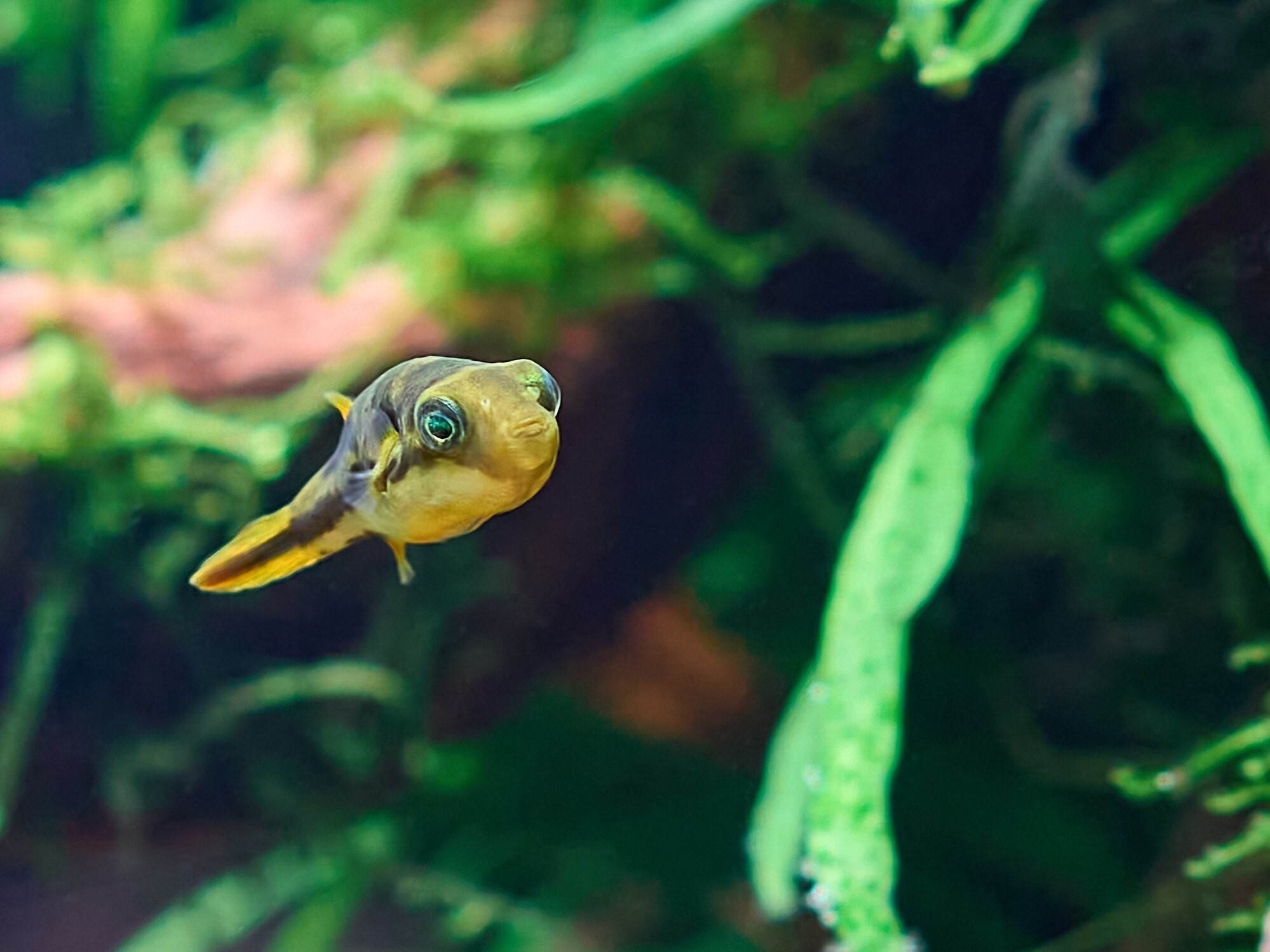

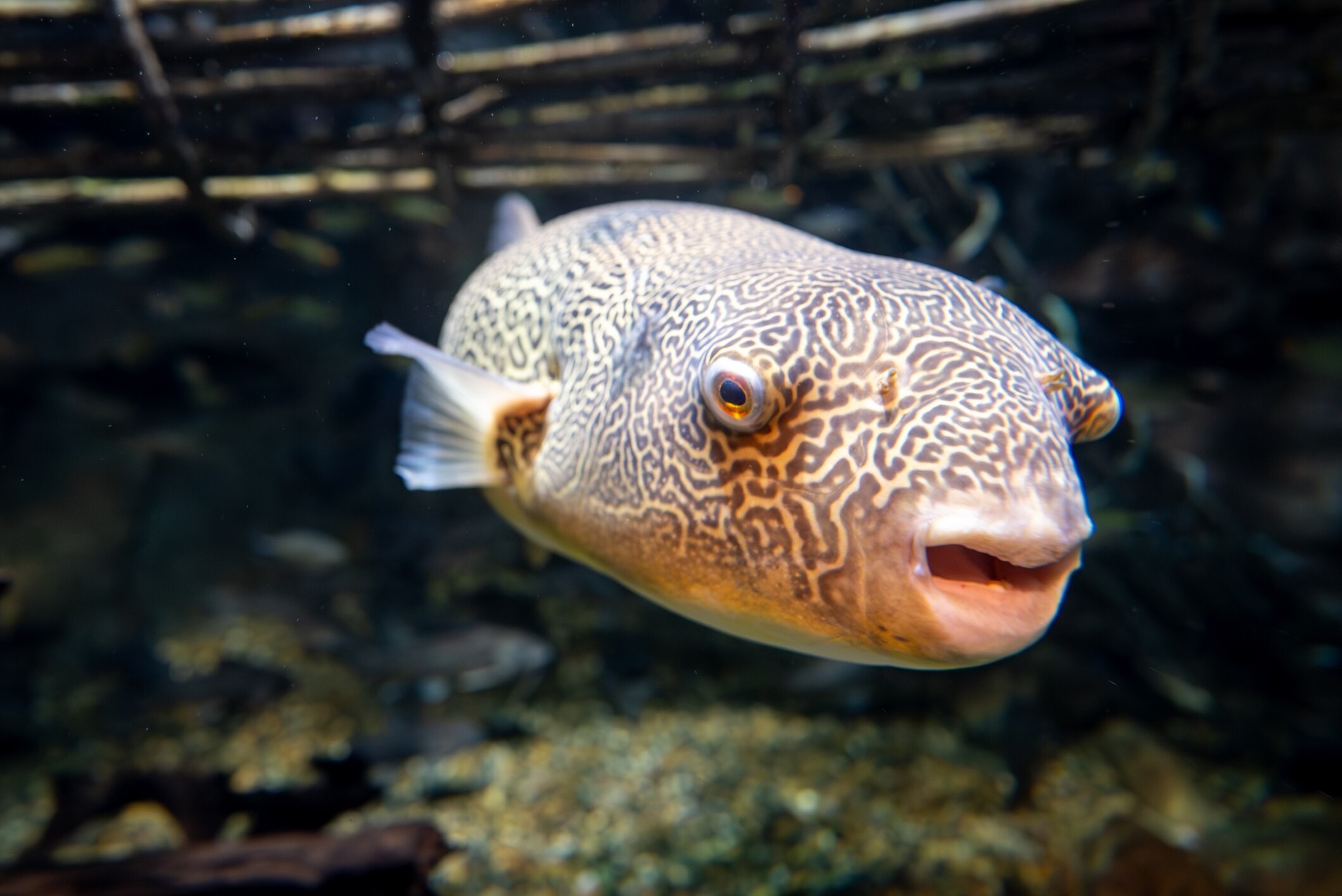
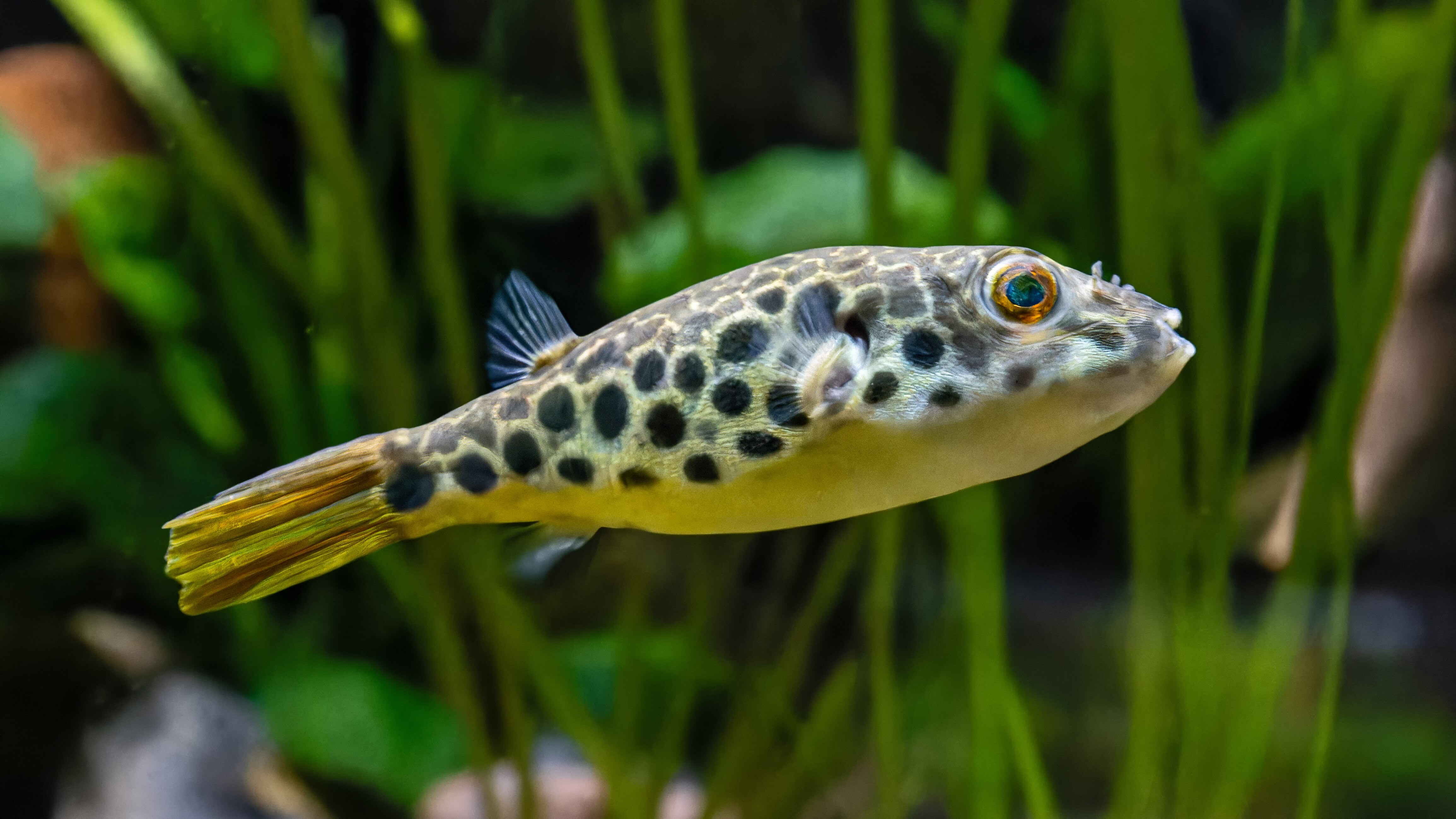
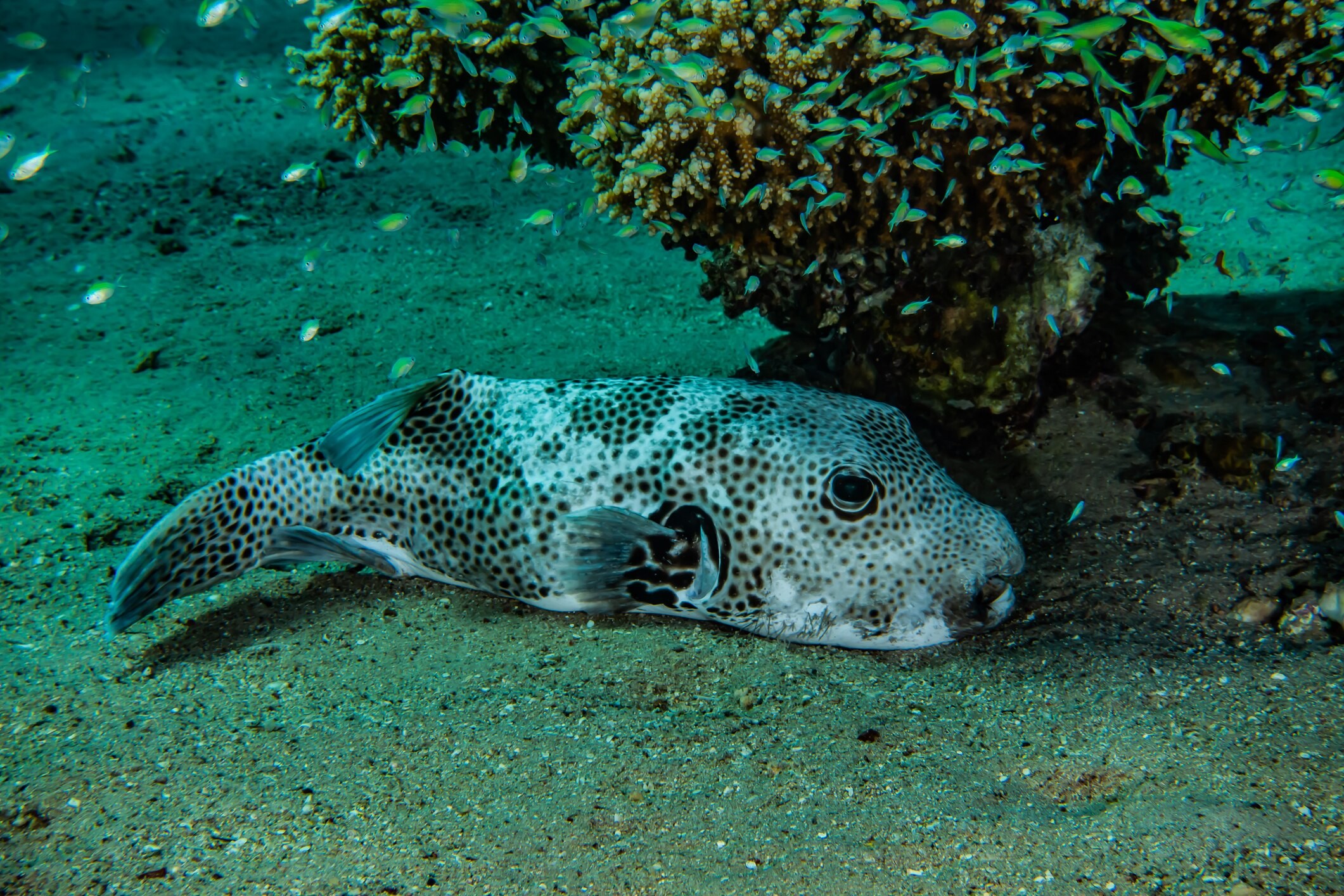
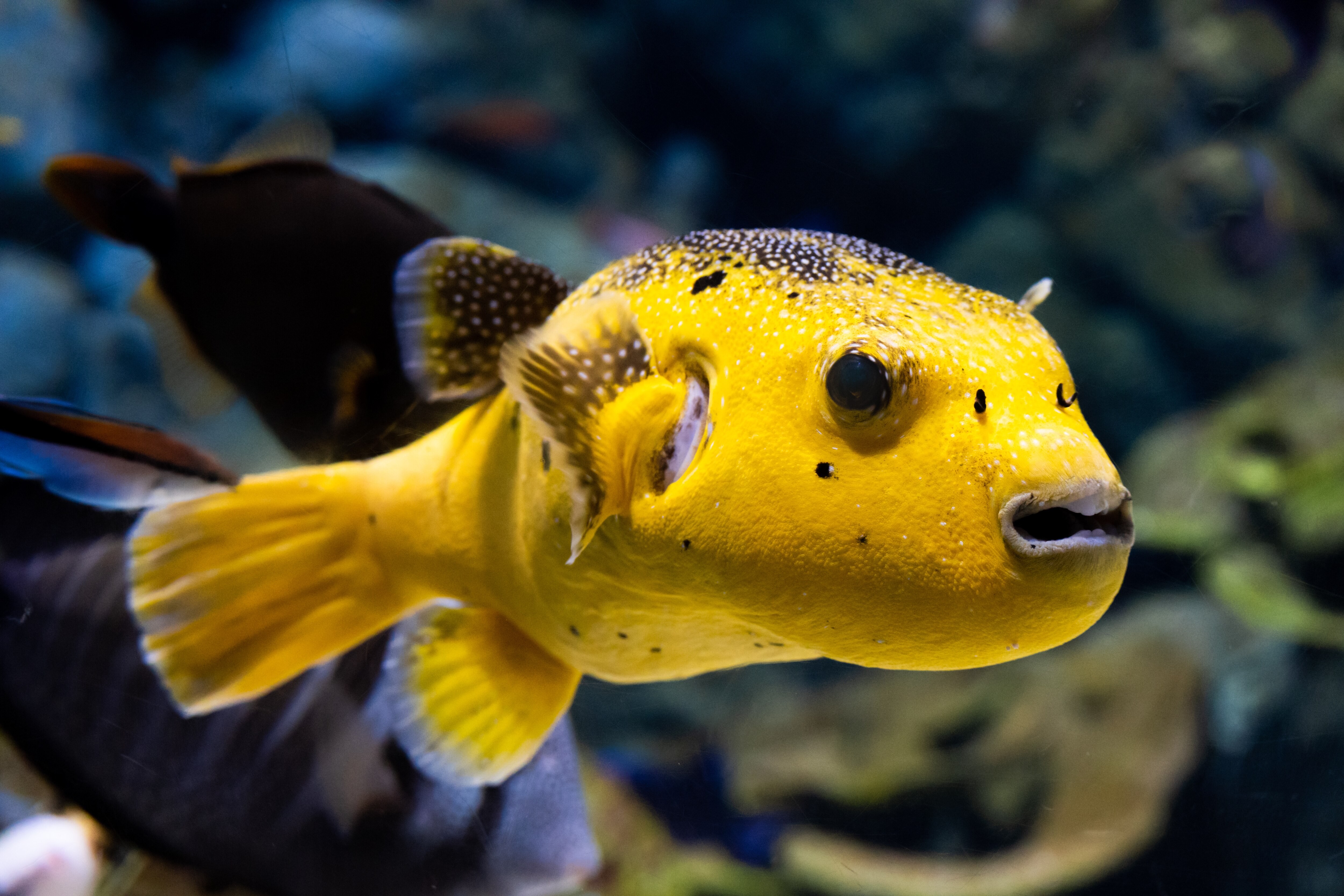
Consider a rectangular tank shape, as it provides more swimming space than a tall or cylindrical tank.
2.2. Essential Equipment for a Pufferfish Tank
- Filtration System: A powerful filter is essential to maintain water quality. Choose a filter rated for a larger tank than you have, and consider using a combination of mechanical, chemical, and biological filtration.
- Heater and Thermostat: Pufferfish require a stable water temperature, typically between 76°F and 82°F (24°C and 28°C). Use a reliable heater and thermostat to maintain the desired temperature.
- Lighting: Pufferfish don’t have specific lighting requirements, but providing a regular day-night cycle is beneficial. Choose a light that suits your aesthetic preferences and supports plant growth if you plan to include live plants.
- Substrate: The substrate is the material that covers the bottom of the tank. Sand is often recommended for pufferfish, as it allows them to sift through it for food and prevents them from damaging their mouths on sharp gravel.
- Decorations: Pufferfish need plenty of hiding places and visual barriers to feel secure. Use rocks, driftwood, plants, and other decorations to create a stimulating and enriching environment.
2.3. Water Parameters: Maintaining a Healthy Environment
Maintaining proper water parameters is crucial for the health of your pufferfish. Here are the key parameters to monitor:
- Ammonia and Nitrite: These are toxic to fish and should always be at 0 ppm (parts per million).
- Nitrate: Keep nitrate levels below 20 ppm through regular water changes.
- pH: Maintain a stable pH level between 7.0 and 8.0, depending on the species.
- Salinity: Brackish water pufferfish require a specific salinity level, typically between 1.005 and 1.015 specific gravity. Use a hydrometer or refractometer to measure salinity.
Test your water regularly using a reliable test kit and adjust parameters as needed.
Alt text: A group of Amazon Puffer fish swimming gracefully in their natural habitat, showcasing their social behavior.
3. Pufferfish Diet and Feeding
Pufferfish have unique dietary needs and require a varied diet to maintain their health and well-being.
3.1. Natural Diet and Nutritional Needs
In the wild, pufferfish feed on a variety of invertebrates, including crustaceans, mollusks, and worms. Their beak-like mouth is perfectly adapted for crushing shells and extracting the nutritious meat inside.
In captivity, it’s essential to replicate their natural diet as closely as possible. Pufferfish require a diet rich in protein, vitamins, and minerals.
3.2. Recommended Foods for Pufferfish
- Live Foods: Live foods such as snails, shrimp, and worms are excellent for stimulating a pufferfish’s natural hunting instincts and providing essential nutrients.
- Frozen Foods: Frozen foods such as bloodworms, mysis shrimp, and krill are a convenient and nutritious option.
- Shelled Foods: Providing shelled foods such as snails and shrimp is essential for keeping a pufferfish’s beak trimmed and preventing overgrowth.
- Commercial Pufferfish Food: Some commercial pufferfish foods are formulated to meet their specific nutritional needs. Choose a high-quality food that contains a variety of ingredients.
3.3. Feeding Schedule and Portion Control
Pufferfish should be fed once or twice a day, depending on their age and size. Offer only as much food as they can consume in a few minutes to avoid overfeeding and water pollution.
Monitor your pufferfish’s body condition and adjust their food intake accordingly. A healthy pufferfish should have a rounded belly but not be excessively bloated.
4. Common Pufferfish Diseases and Health Issues
Pufferfish are susceptible to a variety of diseases and health issues, particularly when kept in poor water conditions.
4.1. Identifying Signs of Illness
Early detection is crucial for successful treatment. Here are some common signs of illness in pufferfish:
- Loss of Appetite: A sudden decrease in appetite can indicate a variety of health problems.
- Lethargy: A sluggish or inactive pufferfish may be ill.
- Changes in Color: Pale or faded coloration can be a sign of stress or disease.
- Bloating: Excessive bloating can indicate constipation or internal parasites.
- White Spots or Patches: These can indicate parasitic infections such as ich (white spot disease).
- Difficulty Breathing: Gasping for air or staying near the surface of the water can indicate respiratory problems.
4.2. Common Diseases and Treatments
- Ich (White Spot Disease): This parasitic infection is characterized by small white spots on the body and fins. Treat with a commercial ich medication according to the manufacturer’s instructions.
- Parasitic Infections: Pufferfish can be susceptible to a variety of internal and external parasites. Treat with an appropriate anti-parasitic medication.
- Bacterial Infections: Bacterial infections can cause a variety of symptoms, including fin rot, ulcers, and pop-eye. Treat with an appropriate antibiotic medication.
- Malnutrition: Malnutrition can result from a poor diet or an inability to absorb nutrients. Ensure your pufferfish is receiving a balanced diet and consider supplementing with vitamins and minerals.
- Beak Overgrowth: If a pufferfish’s beak becomes overgrown, it can interfere with their ability to eat. Provide plenty of shelled foods to help keep their beak trimmed. In severe cases, a veterinarian may need to trim the beak.
4.3. Preventative Care and Quarantine Procedures
Preventative care is the best way to keep your pufferfish healthy. Maintain excellent water quality, provide a balanced diet, and monitor your fish regularly for signs of illness.
Quarantine new fish for at least two weeks before introducing them to your main tank. This will help prevent the spread of disease.
Alt text: A majestic Mbu Puffer fish showcasing its impressive size and intricate patterns, highlighting the species’ unique appeal.
5. Pufferfish Tank Mates: Compatibility and Considerations
Choosing the right tank mates for pufferfish can be challenging, as many species are known for their aggressive or predatory behavior.
5.1. General Compatibility Guidelines
- Avoid Slow-Moving or Long-Finned Fish: Pufferfish may nip at the fins of slow-moving or long-finned fish.
- Avoid Small Fish: Pufferfish may eat small fish that can fit in their mouths.
- Avoid Invertebrates: Pufferfish will typically eat invertebrates such as shrimp, snails, and crabs.
- Choose Tank Mates of Similar Size and Temperament: If you choose to keep pufferfish with other fish, select species of similar size and temperament.
- Provide Plenty of Space and Hiding Places: A large tank with plenty of hiding places can help reduce aggression and territoriality.
5.2. Recommended Tank Mates for Specific Species
- Dwarf Puffers: Can be kept in a species-only tank or with small, peaceful fish such as Otocinclus catfish.
- Figure 8 Puffers: Best kept in a species-only tank.
- Green Spotted Puffers: Can be kept with larger, more robust fish such as Monos and Scats in a brackish water aquarium.
- Amazon Puffers: Can be kept with other peaceful South American fish such as tetras and Corydoras catfish.
- Mbu Puffers: Best kept in a species-only tank due to their large size and aggressive nature.
5.3. Tank Mates to Avoid
- Angelfish: Their flowing fins are tempting targets.
- Guppies: They are too small and defenseless.
- Shrimp: They will be seen as food.
- Most invertebrates: Same as shrimp, they will be consumed.
6. Breeding Pufferfish: A Challenging but Rewarding Endeavor
Breeding pufferfish in captivity can be challenging, but it is possible with the right knowledge and dedication.
6.1. Understanding Breeding Behaviors
Pufferfish breeding behaviors vary depending on the species. Some species are egg-scatterers, while others are nest-builders or mouthbrooders.
Research the specific breeding behaviors of your chosen species before attempting to breed them.
6.2. Creating the Ideal Breeding Environment
To encourage breeding, provide a suitable environment with optimal water parameters, plenty of hiding places, and a varied diet.
Some species require specific water conditions or spawning substrates to breed.
6.3. Raising Pufferfish Fry
Pufferfish fry are typically very small and require specialized care. They need to be fed small live foods such as baby brine shrimp or infusoria.
Maintain excellent water quality and provide plenty of hiding places to protect the fry from predation.
Alt text: An eye-level shot of a Spotted Congo Puffer Fish in an aquarium, highlighting its unique spotted pattern and curious expression.
7. Ethical Considerations: Responsible Pufferfish Ownership
Before acquiring a pufferfish, it’s essential to consider the ethical implications of keeping these animals in captivity.
7.1. Sourcing Pufferfish Responsibly
Purchase pufferfish from reputable breeders or suppliers who prioritize the health and well-being of their animals. Avoid purchasing wild-caught pufferfish, as this can contribute to the decline of wild populations.
7.2. Providing a Stimulating and Enriching Environment
Pufferfish are intelligent and active animals that require a stimulating and enriching environment. Provide plenty of space, hiding places, and opportunities for exploration and play.
7.3. Understanding the Lifespan and Long-Term Commitment
Pufferfish can live for many years, so be prepared to provide them with long-term care. Ensure you have the resources and commitment to meet their needs for the duration of their lives.
8. The Joys and Challenges of Pufferfish Keeping
Keeping pufferfish can be a rewarding experience, but it also comes with its share of challenges.
8.1. The Unique Appeal of Pufferfish
Pufferfish are fascinating and unique creatures that can bring a lot of joy to their owners. Their playful personalities, intelligence, and distinctive appearance make them captivating additions to any aquarium.
8.2. Potential Challenges and How to Overcome Them
- Aggression: Some pufferfish species can be aggressive towards tank mates. Provide plenty of space and hiding places, and choose tank mates carefully.
- Dietary Needs: Pufferfish require a varied diet of live, frozen, and shelled foods. Research their specific dietary needs and be prepared to provide a balanced diet.
- Water Quality: Pufferfish are sensitive to poor water quality. Maintain excellent water quality through regular water changes, filtration, and monitoring of water parameters.
- Disease: Pufferfish are susceptible to a variety of diseases. Monitor your fish regularly for signs of illness and treat promptly.
8.3. Is a Pufferfish Right for You? Making an Informed Decision
Before bringing a pufferfish home, carefully consider your ability to meet their specific needs. Pufferfish require a significant commitment of time, resources, and knowledge.
If you are prepared to provide them with the care they need, pufferfish can be rewarding and fascinating pets.
9. Advanced Pufferfish Care Techniques
For experienced pufferfish keepers, here are some advanced techniques to consider:
9.1. Aquascaping for Pufferfish
Create a visually appealing and functional aquascape that provides plenty of hiding places, swimming space, and opportunities for exploration.
Use a variety of rocks, driftwood, and plants to create a natural-looking environment.
9.2. Training and Enrichment
Pufferfish are intelligent and can be trained to perform simple tricks, such as feeding from your hand or swimming through hoops.
Provide them with a variety of enrichment activities to keep them mentally stimulated.
9.3. Advanced Filtration Techniques
Consider using advanced filtration techniques such as refugiums or protein skimmers to maintain optimal water quality.
Alt text: A captivating portrait of a Dragon Puffer fish, showcasing its unique humpback shape and intricate skin patterns.
10. Pufferfish Conservation and Sustainability
As responsible pet owners, it’s important to be aware of the conservation status of pufferfish and to support sustainable practices.
10.1. Conservation Status of Different Species
Some pufferfish species are threatened or endangered due to habitat loss, overfishing, and the aquarium trade.
Research the conservation status of your chosen species and support efforts to protect their natural habitats.
10.2. Sustainable Aquarium Practices
- Purchase Captive-Bred Fish: Choose captive-bred pufferfish whenever possible to reduce the demand for wild-caught specimens.
- Support Sustainable Fisheries: Purchase seafood from sustainable fisheries to reduce the impact on wild pufferfish populations.
- Reduce Your Carbon Footprint: Reduce your carbon footprint by conserving energy, using public transportation, and supporting sustainable businesses.
10.3. Supporting Pufferfish Conservation Efforts
Donate to organizations that are working to protect pufferfish and their habitats.
Educate others about the importance of pufferfish conservation.
11. Resources for Pufferfish Keepers
There are many valuable resources available for pufferfish keepers.
11.1. Online Forums and Communities
Join online forums and communities to connect with other pufferfish keepers, share information, and ask questions.
11.2. Books and Articles
Read books and articles about pufferfish care to expand your knowledge.
11.3. Veterinarians and Aquatic Specialists
Find a veterinarian or aquatic specialist who is experienced in treating pufferfish.
12. The Future of Pufferfish Keeping
Pufferfish keeping is an evolving field, and new information and techniques are constantly emerging.
12.1. Emerging Trends in Pufferfish Care
- Biotope Aquariums: Creating aquariums that replicate the natural habitats of pufferfish.
- Advanced Filtration Systems: Using advanced filtration systems to maintain optimal water quality.
- Species-Specific Diets: Developing species-specific diets to meet the unique nutritional needs of different pufferfish species.
12.2. Research and Conservation Efforts
Continued research and conservation efforts are essential for ensuring the long-term survival of pufferfish in the wild.
12.3. The Role of Responsible Pet Ownership
Responsible pet ownership plays a crucial role in the future of pufferfish keeping and conservation. By providing our pufferfish with the best possible care and supporting sustainable practices, we can help ensure that these amazing creatures continue to thrive for generations to come.
Choosing a pufferfish as a pet requires careful consideration and a commitment to providing specialized care. By understanding their unique needs and challenges, you can create a thriving environment where these fascinating creatures can flourish. Remember to consult PETS.EDU.VN for detailed care sheets, species-specific guides, and expert advice to enhance your pufferfish keeping journey. Understanding the unique care requirements of pufferfish contributes to responsible pet ownership and ensures the well-being of these captivating aquatic animals. Explore more about aquatic pet keeping, species selection, and aquarium maintenance through our resources.
Alt text: A vibrant image of a Yellow Puffer fish, showcasing its golden coloration and distinctive features in an aquarium setting.
FAQ About Keeping Pufferfish
-
Are pufferfish poisonous to touch?
- While many pufferfish contain tetrodotoxin, a potent neurotoxin, it’s primarily found in their internal organs. Touching a pufferfish is generally safe, but it’s best to avoid handling them to minimize stress.
-
What do pufferfish eat?
- Pufferfish have a varied diet that includes crustaceans, mollusks, and worms. In captivity, they can be fed live, frozen, and shelled foods to meet their nutritional needs and keep their beaks trimmed.
-
How big do pufferfish get?
- The size of pufferfish varies greatly depending on the species. Dwarf puffers are less than an inch long, while Mbu puffers can grow up to 30 inches.
-
Can pufferfish live in freshwater?
- Some pufferfish species, such as the dwarf puffer and Amazon puffer, can live in freshwater. Other species, such as the green spotted puffer and figure 8 puffer, require brackish water.
-
Are pufferfish aggressive?
- Some pufferfish species are known for their aggressive behavior, while others are more peaceful. Research the temperament of your chosen species and be prepared to house them alone or with compatible tank mates.
-
What size tank do I need for a pufferfish?
- The size of the tank depends on the species. Dwarf puffers can be kept in a 5-gallon tank, while Mbu puffers require a tank of 250 gallons or more.
-
How long do pufferfish live?
- The lifespan of pufferfish varies depending on the species. Some species live for only a few years, while others can live for over 20 years.
-
How do I keep my pufferfish healthy?
- Maintain excellent water quality, provide a balanced diet, and monitor your fish regularly for signs of illness. Quarantine new fish for at least two weeks before introducing them to your main tank.
-
What are the best tank mates for pufferfish?
- Choosing the right tank mates for pufferfish can be challenging. Avoid slow-moving or long-finned fish, small fish, and invertebrates. Choose tank mates of similar size and temperament and provide plenty of space and hiding places.
-
Are pufferfish good pets?
- Pufferfish can be rewarding and fascinating pets for experienced aquarists who are prepared to meet their specific needs. They require a significant commitment of time, resources, and knowledge.
For further assistance and detailed information about pufferfish care, don’t hesitate to contact us at PETS.EDU.VN. Visit us at 789 Paw Lane, Petville, CA 91234, United States, or reach out via Whatsapp at +1 555-987-6543. We’re here to help you create the best possible environment for your aquatic companions. Remember, responsible pet ownership starts with education and dedication. Visit pets.edu.vn for comprehensive care guides and expert advice.